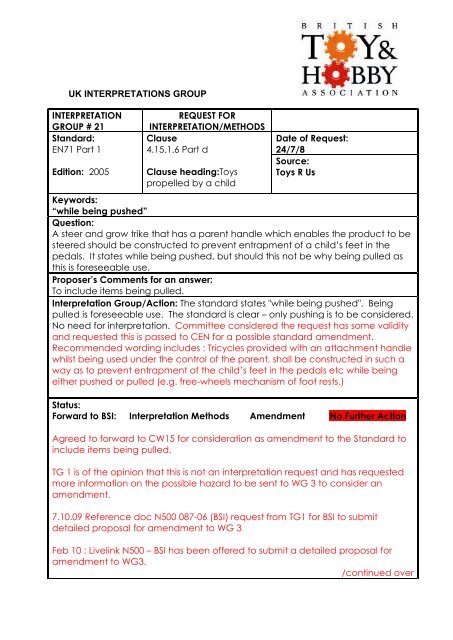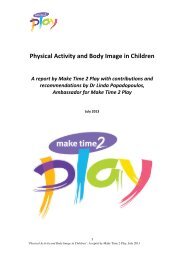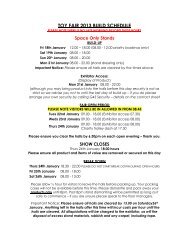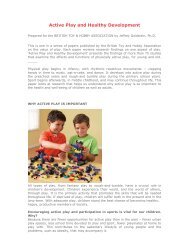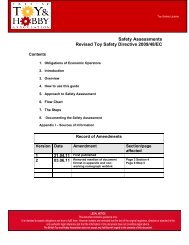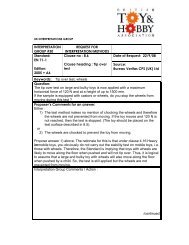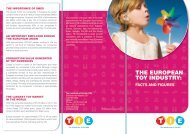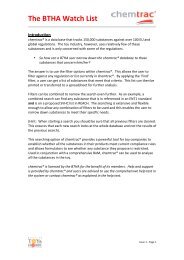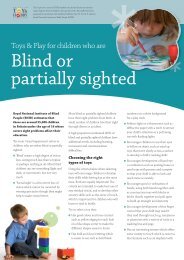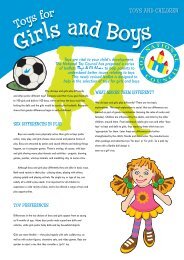021 EN71-1:2005 Clause 4.15.1.6 Part (d) Toys propelled by a child
021 EN71-1:2005 Clause 4.15.1.6 Part (d) Toys propelled by a child
021 EN71-1:2005 Clause 4.15.1.6 Part (d) Toys propelled by a child
You also want an ePaper? Increase the reach of your titles
YUMPU automatically turns print PDFs into web optimized ePapers that Google loves.
UK INTERPRETATIONS GROUP<br />
INTERPRETATION<br />
GROUP # 21<br />
Standard:<br />
<strong>EN71</strong> <strong>Part</strong> 1<br />
Edition: <strong>2005</strong><br />
REQUEST FOR<br />
INTERPRETATION/METHODS<br />
<strong>Clause</strong><br />
<strong>4.15.1.6</strong> <strong>Part</strong> d<br />
<strong>Clause</strong> heading:<strong>Toys</strong><br />
<strong>propelled</strong> <strong>by</strong> a <strong>child</strong><br />
Date of Request:<br />
24/7/8<br />
Source:<br />
<strong>Toys</strong> R Us<br />
Keywords:<br />
“while being pushed”<br />
Question:<br />
A steer and grow trike that has a parent handle which enables the product to be<br />
steered should be constructed to prevent entrapment of a <strong>child</strong>’s feet in the<br />
pedals. It states while being pushed, but should this not be why being pulled as<br />
this is foreseeable use.<br />
Proposer’s Comments for an answer:<br />
To include items being pulled.<br />
Interpretation Group/Action: The standard states "while being pushed". Being<br />
pulled is foreseeable use. The standard is clear – only pushing is to be considered.<br />
No need for interpretation. Committee considered the request has some validity<br />
and requested this is passed to CEN for a possible standard amendment.<br />
Recommended wording includes : Tricycles provided with an attachment handle<br />
whilst being used under the control of the parent, shall be constructed in such a<br />
way as to prevent entrapment of the <strong>child</strong>’s feet in the pedals etc while being<br />
either pushed or pulled (e.g. free-wheels mechanism of foot rests.)<br />
Status:<br />
Forward to BSI: Interpretation Methods Amendment No Further Action<br />
Agreed to forward to CW15 for consideration as amendment to the Standard to<br />
include items being pulled.<br />
TG 1 is of the opinion that this is not an interpretation request and has requested<br />
more information on the possible hazard to be sent to WG 3 to consider an<br />
amendment.<br />
7.10.09 Reference doc N500 087-06 (BSI) request from TG1 for BSI to submit<br />
detailed proposal for amendment to WG 3<br />
Feb 10 : Livelink N500 – BSI has been offered to submit a detailed proposal for<br />
amendment to WG3.<br />
/continued over
UK INTERPRETATIONS GROUP<br />
19.7.2010 This issue may have been driven <strong>by</strong> complaints and may be an<br />
amendment rather than interpretation. RS / MS to check for any complaints /<br />
injury data.<br />
28.10.2011 The additional hazard of a toy being pulled was considered <strong>by</strong> TG1<br />
but was not added to <strong>EN71</strong>-1: 2011. As accident data is limited and there is no<br />
technical solution, the issued should be closed. This was agreed <strong>by</strong> all. (#<strong>021</strong> to<br />
be closed.)<br />
CEN/TC 52/TG 1 N 81 Rev2<br />
10/21<br />
TG members<br />
Comments:<br />
Dominique Jan 08: I cannot disagree with this. Should we propose to amend the standard to<br />
replace “while<br />
being pushed” <strong>by</strong> “while being pushed or pulled”?<br />
Clive Jan 09: Perhaps “whilst being pushed or pulled as appropriate” would be the best text.<br />
Sanda Jan 13 I would be interested to know if there is an identified hazard related to this<br />
question.<br />
Knowing the background may be needed to make a sensible amendment. If it is only a<br />
“theoretical”<br />
question we may decide not to amend the standard in order to limit the number of<br />
amendments.<br />
Malcolm Jan 13, Is it possible that we can make an interpretation that being pulled is<br />
technically<br />
the same as being pushed? If not then an amendment would be needed.<br />
Rolf Jan. 14 I think Malcolm is right. One important toy-vehicle manufacturer told me that<br />
pulled or<br />
pushed has to be technically the same, the pedals should have been moved <strong>by</strong> the <strong>child</strong><br />
only in all<br />
directions and not <strong>by</strong> turning the wheels (no rigid drive).<br />
Sanda, the manufacturer told me that the most accidents in the past arose <strong>by</strong> pulling<br />
backwards<br />
<strong>by</strong> adults.<br />
Karina-Jan 15 : We have checked in the EU market there are some vehicles which are constructed<br />
to<br />
prevent entrapment of the feet only while being pushed. It would be necessary to know the<br />
accidents data<br />
before proposing and amendment.<br />
Natale-Jan 21: It is not possible to amend this requirement without a deep discussion. EN 71-1<br />
reads<br />
“Tricycles provided with an attached handle used for pushing the <strong>child</strong>, shall be constructed in such<br />
a way<br />
as to prevent entrapment of the <strong>child</strong>’s feet in the pedals etc. while being pushed (e.g. freewheeling<br />
mechanism or foot rests).”<br />
Thus EN 71-1 says that an acceptable solution to meet the requirement is to have a free-wheeling
UK INTERPRETATIONS GROUP<br />
mechanism. A free-wheeling mechanism is a mechanism which is widely used (all adults bicycles<br />
have it)<br />
and which allows to transfer the motion from the pedals to the wheels if riding forward, and not to<br />
transfer<br />
any motion between the pedals and the wheels (and vice versa) if riding backward.<br />
On a bicycle or tricycle with such a feature, if the <strong>child</strong> rotates the pedals forward, the bicycle<br />
moves, if it<br />
rotates the pedals backward, the bicycle does not move.<br />
This also means that if the tricycle is pushed forward, if the <strong>child</strong> keeps its feet still the pedals do<br />
not rotate.<br />
But if the tricycle is pulled backward, the pedals rotate.<br />
Thus, if we change the requirement, EN 71-1 shall be deeply changed and what is now suggested<br />
<strong>by</strong> the<br />
standard itself (free-wheeling mechanism) will become banned. And a huge amount of products<br />
currently<br />
on the market having the free-wheeling feature, will be considered as dangerous.<br />
Helen Jan 23<br />
I agree that this needs further discussion in WG3. To me it is on the border line to call it an<br />
interpretation of<br />
the standard.<br />
Christian Jan 23. I don´t think anybody is suggesting that we make an interpretation – all seem to<br />
be in<br />
favour of an amendment. I agree fully with Natale and think that an amendment would perhaps be a<br />
requirement for a warning on the handle intended for use on tricycles with free-wheeling<br />
mechanism, e.g<br />
“Risk for feet antrapment: Do not use the handle to pull the tricycle backwards”<br />
Dominique April 2009: to be further discussed during the next meeting in Milan.<br />
Milan 09: TG 1 is of the opinion that this request is not a request for interpretation and<br />
recommends BSI to substantiate this request <strong>by</strong> providing more information on a possible<br />
hazard.<br />
This information should then be directly sent out to WG 3 for consideration if an amendment<br />
is<br />
considered necessary.


